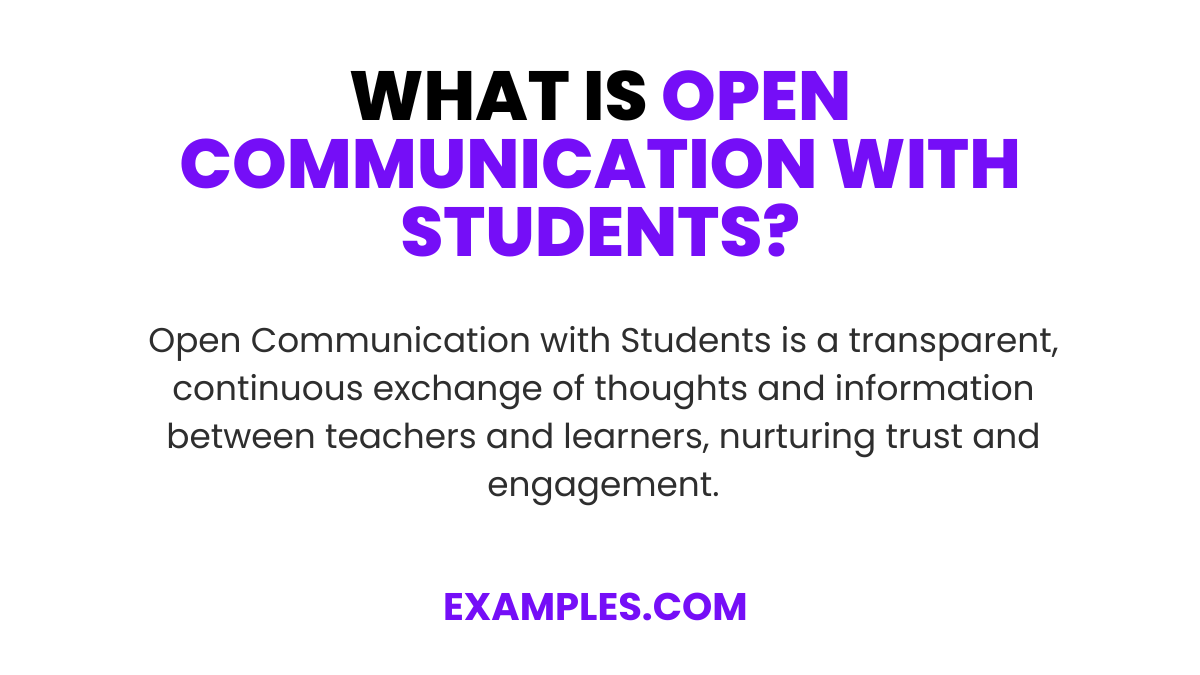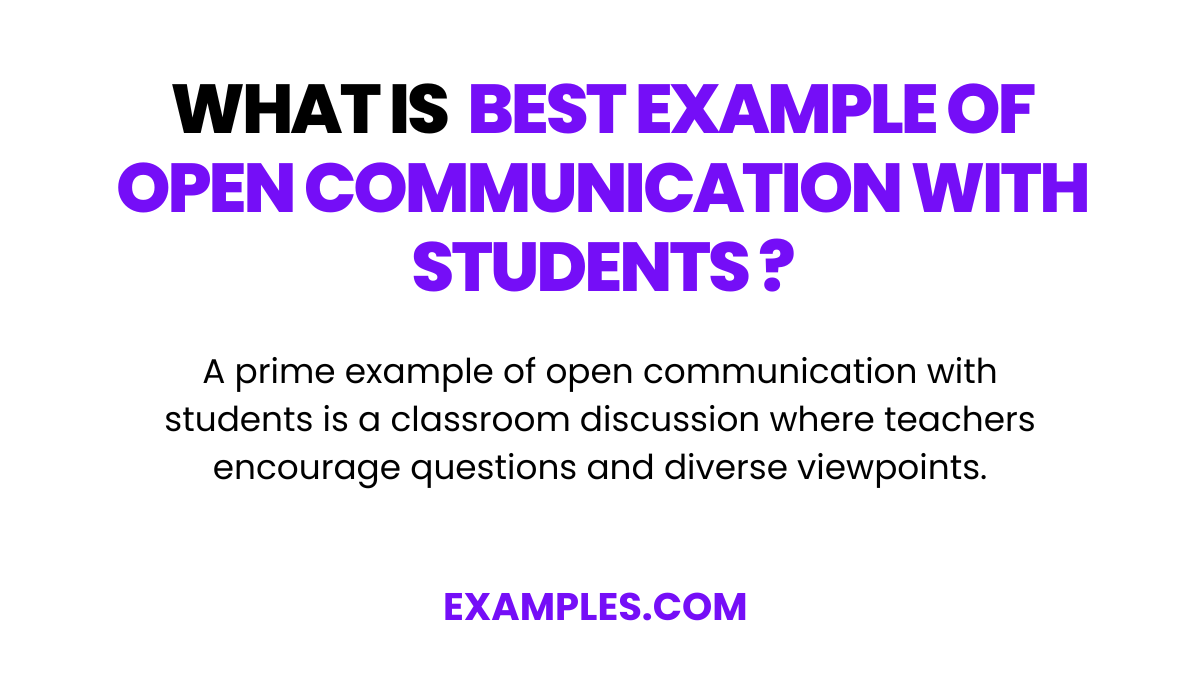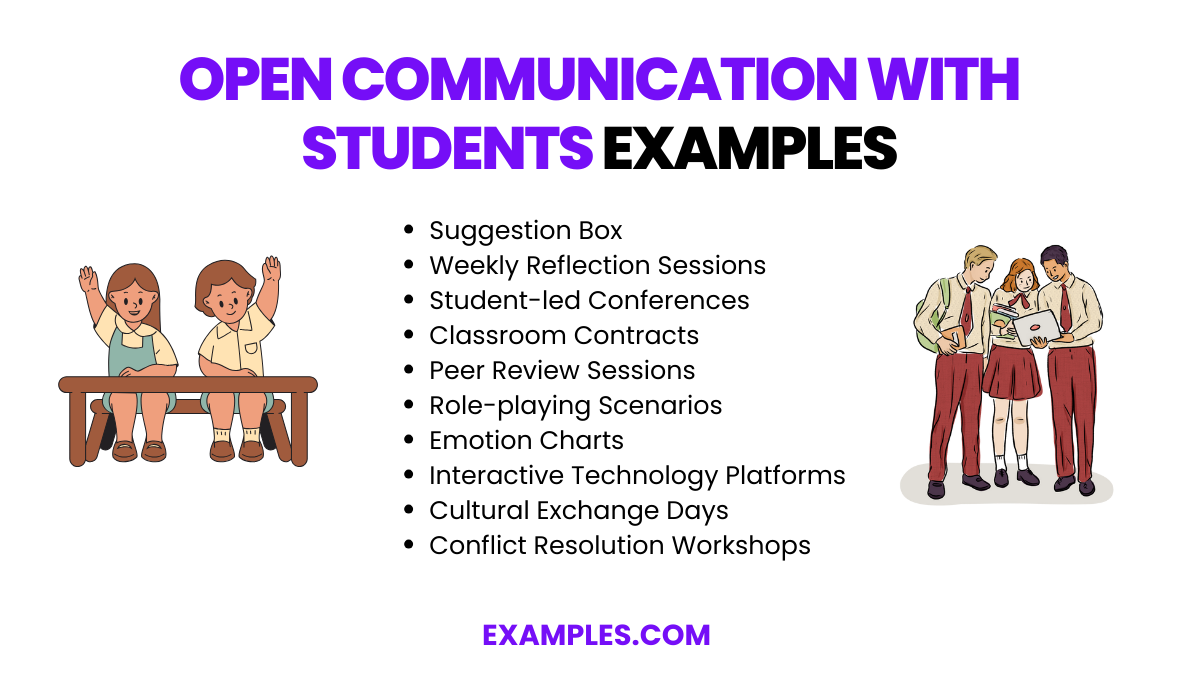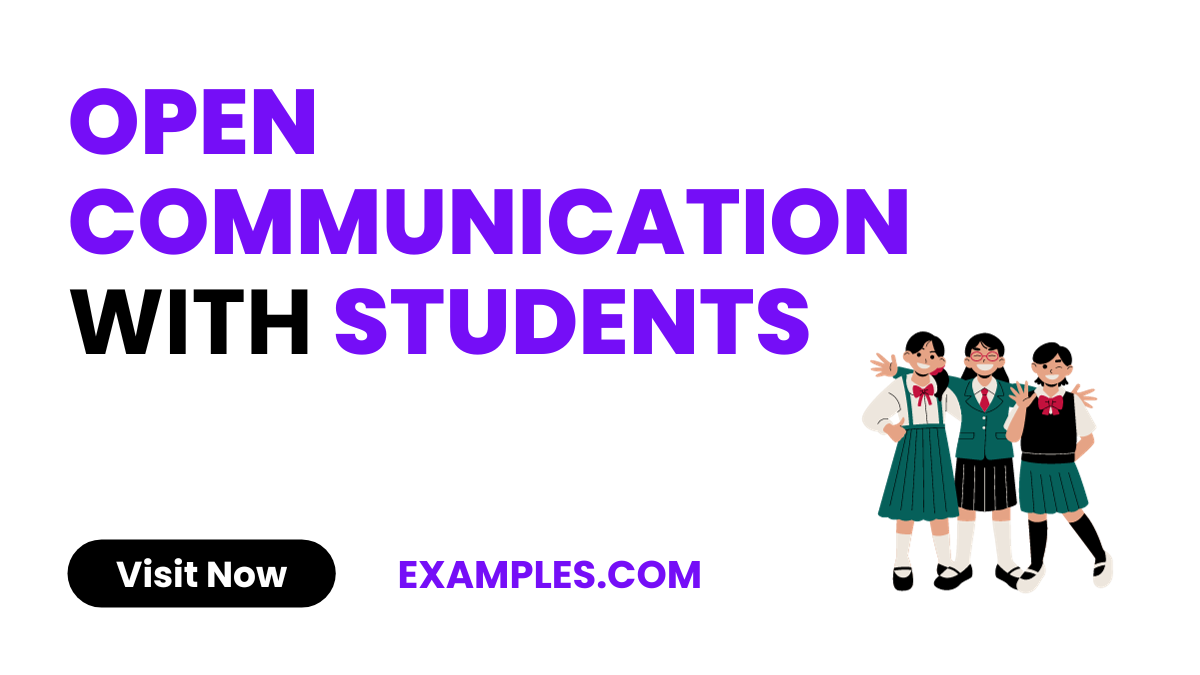10+ Open Communication with Students Examples
Dive into the transformative world of Open Communication with Students with our comprehensive guide. Discover the power of transparent, two-way dialogues in educational settings through vivid Communication Examples. This resource is tailored to educators seeking to enhance engagement, trust, and learning outcomes, employing proven communication strategies that resonate with students of all ages.
Download Teacher-student Communication In the Classroom PDF
What is Open Communication with Students? – Meaning

Open Communication with Students refers to the clear, honest, and ongoing dialogue between teachers and students. It’s an approach where thoughts, feelings, and information are freely exchanged, encouraging questions and discussions. This method fosters a trusting, supportive classroom environment, allowing students to express themselves and teachers to understand and respond to student needs effectively.
What is the Best Example of Open Communication with Students?

The best example of open communication with students might be a teacher encouraging students to share their thoughts and questions during a class discussion, without fear of judgment. Here, the teacher actively listens, acknowledges the students’ contributions, and provides constructive feedback. This not only makes students feel valued but also promotes a culture of curiosity and continuous learning. An instance of this could be during a lesson on historical events where the teacher invites students to express their interpretations of the events and then discusses these viewpoints openly, fostering a richer, more inclusive understanding of the subject.
10 Open Communication with Students Examples

Delve into the impactful world of Open Communication with Students with these 20 unique examples. Each instance showcases the necessity and effectiveness of fostering an environment where thoughts and ideas flow freely between educators and learners. Incorporating Open Communication Benefits and understanding the Importance of Open Communication within the educational sphere leads to a more engaging, supportive, and effective learning experience.
- Suggestion Box: A teacher sets up an anonymous suggestion box in the classroom.
- Cause: Students might feel hesitant to voice concerns publicly.
- Fix: The suggestion box allows a safe space for honest feedback, reflecting Open Communication in Healthcare where patients also provide feedback anonymously.
- Weekly Reflection Sessions: Teachers hold a weekly open forum for students to discuss the past week’s highs and lows.
- Cause: Lack of regular feedback loops between students and teachers.
- Fix: Regular sessions ensure ongoing dialogue, akin to Open Communication in the Workplace, fostering a continuous feedback culture.
- Student-led Conferences: Instead of traditional parent-teacher meetings, students lead the discussion about their progress.
- Cause: Students often feel left out of the conversation about their education.
- Fix: This method promotes Open Communication with Parents, making students active participants in their educational journey.
- Classroom Contracts: At the start of the year, teachers and students create a set of communication rules together.
- Cause: Preset rules might not resonate with every classroom dynamic.
- Fix: Creating contracts together underlines the Importance of Open Communication in Relationship within the classroom setting.
- Peer Review Sessions: Students are encouraged to review and provide feedback on each other’s work.
- Cause: Single-source feedback might not provide diverse perspectives.
- Fix: Peer reviews encourage Honest Communication among students, similar to peer reviews in professional settings.
- Role-playing Scenarios: Teachers use role-play to act out various communication situations with students.
- Cause: Students might not understand the impact of different communication styles.
- Fix: Role-playing helps students understand Open Communication Benefits firsthand by experiencing different scenarios.
- Emotion Charts: Classrooms have emotion charts where students can express how they feel each day.
- Cause: Emotional states might affect student participation and are often unspoken.
- Fix: Emotion charts promote Open Mind Communication, allowing teachers to tailor their approach to students’ current emotional states.
- Interactive Technology Platforms: Utilizing digital forums or apps for classroom discussions and feedback.
- Cause: Some students might be more comfortable communicating digitally.
- Fix: Technology fosters Open Communication, providing an alternative platform for student expression.
- Cultural Exchange Days: Students share aspects of their culture or background with the class.
- Cause: Cultural misunderstandings can hinder open communication.
- Fix: These days emphasize the Importance of Open Communication, celebrating diversity and fostering mutual respect.
- Conflict Resolution Workshops: Teachers organize workshops to teach and practice conflict resolution skills.
- Cause: Miscommunications and conflicts can disrupt learning.
- Fix: Workshops provide tools for How to Promote Open Communication, equipping students with conflict resolution strategies.
Open Communication with Students in the Classroom
Cultivate Open Communication with Students in the Classroom by integrating Open Communication in Family values and Open Communication in Leadership principles. This nurturing approach, akin to Open Communication with Parents, creates a respectful, engaging environment akin to a supportive family unit, encouraging active participation and honest dialogue.
- Roundtable Discussions: Let’s discuss everyone’s project interests.
- Promotes democratic, inclusive dialogue, mirroring family discussions.
- Feedback Time: Share your thoughts on today’s lesson.
- Invites constructive feedback, fostering a reflective culture.
- Classroom Agreements: What communication rules should we follow?
- Empowers students to shape their learning environment.
- Peer Mentoring Programs: Help a classmate understand today’s topic.
- Encourages teamwork and peer learning, reflecting leadership values.
- Problem-Solving Sessions: Brainstorm solutions for a better class environment.
- Engages students in collaborative problem-solving, enhancing responsibility.
What are the Benefits of Promoting Open Communication with Students in the classroom?
Promoting open communication in the classroom nurtures a learning environment where students feel valued and understood. It’s akin to fostering Open Communication with Colleagues, enhancing collaboration and trust.
- Enhances Learning Environment: Much like Open Communication with Colleagues, open dialogue in the classroom creates a more inclusive and supportive learning space, encouraging students to participate and share.
- Builds Trust and Respect: Open communication fosters a sense of trust and respect between teachers and students, similar to the trust built through Open Communication with Manager in professional settings.
- Improves Conflict Resolution: Just as Open Communication with Stakeholders resolves issues effectively in businesses, in the classroom, it helps address and resolve misunderstandings or conflicts among students.
- Encourages Personal Growth: Students develop better self-expression and advocacy skills, akin to healthcare professionals practicing Open Communication with Patients for improved patient care.
- Promotes Academic Success: Open communication leads to clearer understanding of academic material and expectations, much like clear communication with colleagues leads to better performance and results.
How can Technology and Digital Tools be Used to Enhance Open Communication with Students?
Incorporating technology and digital tools can significantly amplify open communication with students. It’s like using advanced tools for Open Communication with Stakeholders to maintain transparency and engagement.
- Digital Feedback Tools: Utilize tools like online surveys or forums for feedback, akin to how companies might gather feedback from Open Communication with Stakeholders.
- Interactive Platforms: Use educational platforms that allow real-time interaction and collaboration, similar to digital tools used for Open Communication with Colleagues in the workplace.
- Virtual Meeting Spaces: Implement video conferencing tools to facilitate face-to-face communication, much like how professionals maintain Open Communication with Manager remotely.
- Social Media Groups: Create class-specific groups or channels for sharing information and fostering community, reflecting the principles of Open Communication with Patients in healthcare.
- Multimedia Resources: Incorporate videos, podcasts, and interactive modules to convey complex concepts, enhancing understanding and engagement, similar to using varied communication methods with stakeholders.
How to Improve Your Open Communication with Students?
Improving open communication with students involves a multifaceted approach. Firstly, providing students with Communication Skill Training enhances their skills in articulating thoughts and concerns. Secondly, streamline the Communication Process by creating a welcoming environment where students feel comfortable expressing themselves. Encourage questions and feedback, making sure to actively listen. Maintain clarity and transparency in your communication, outlining expectations and learning objectives. Offer constructive feedback and regular assessments. Utilize varied communication modes and remain culturally sensitive. Flexibility is key, adapting your approach to diverse student needs. Lastly, prioritize two-way communication, valuing student input and fostering a collaborative learning environment that supports their growth.
Why is Open Communication with Students Important in an Educational Setting?
Open communication fosters understanding, trust, and engagement, enhancing learning outcomes. It’s crucial for nurturing an environment free from Open Communication vs Closed Communication barriers.
What Strategies can Educators Employ to Foster Open Communication with Students?
Educators can create inclusive dialogue spaces, encourage feedback, and actively listen, similar to strategies used to combat Open Communication vs Direct Communication issues in professional settings.
What are the Benefits of Promoting Open Communication with Students in the classroom?
Open communication fosters trust, engagement, and a positive learning environment. It encourages student participation, understanding, and better problem-solving, ultimately enhancing academic performance and overall well-being.
In conclusion, open communication with students, akin to Open Communication with Child, is a cornerstone of effective education. This article has explored examples, effects, signs, and solutions for fostering such communication. When educators prioritize transparency, active listening, and empathy, they create an environment where students thrive academically and emotionally, ultimately paving the way for lifelong learning and holistic development.



